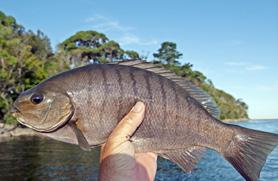
5 minute read
Starlo’s back to basics
NSW STH COAST Steve Starling
www.fishotopia.com
Luderick or blackfish are one of the most prolific species found in the estuaries and coastal seas of our South East: from scientific circles as Girella triscupidata and belongs to a family of omnivorous inshore fishes that also includes the eastern and western black drummer, the blue drummer or bluefish and the zebra fish. All of these species inhabit rocky shorelines and inshore
A catch of blackfish or luderick taken on ‘traditional’ gear consisting of a long, light rod, centrepin reel and a float used to suspend a bait of marine algae such as green weed or ‘sea cabbage’ on a small hook. Starlo poses for a quick luderick ‘selfie’. At 46cm and 1.45kg, this is a very good blackfish by most standards, especially from the estuary.

Queensland to Tasmania. They’re readily available, fun to catch and good to eat, yet many anglers coastal seas, but the luderick extends that range well up our estuaries, occasionally straying into water that’s
fresh enough to drink.
Geographically, luderick extend from about Moreton Bay in southeastern Queensland to the north and east coasts of Tasmania, and while they become increasingly rare west of Wilsons Promontory, the odd stray specimen can turn up around Melbourne at times, and possibly even as far as South Australian waters, although they’re certainly not predictable enough that far west to be
actively targeted.
Over the last few decades, the distribution of luderick appears to have shifted somewhat, perhaps due to increasing water temperatures and changes in ocean currents. According to many observers, they are now nowhere near as abundant nor reliable in southern Queensland waters as they once were, and have even thinned out a tad along the NSW far north coast, especially during summer and early autumn when those waters are at their warmest. At the
other end of their range, however, luderick are now turning up more frequently in Tasmania’s north east and east, with smaller numbers even being encountered around the Apple Isle’s north western corner.
Luderick have a diverse diet. They eat a heck of a lot of marine algae or weed, but also snack on all manner of smaller invertebrates such as worms, yabbies, shrimps, prawns and the like. For this reason, they’re occasionally caught as ‘by-catch’ on various baits and even lures and flies. However, the specialists who target them (especially in NSW) prefer to use floats to suspend weed baits rigged on small hooks and light leaders at various depths, either in the estuaries or along ocean rock ledges, breakwalls and from bridges, wharves or jetties.
‘Traditional’ blackfish gear consists of long, light rods (typically 3-4m in length) matched up to simple, direct drive centrepin reels, but you can certainly use spinning or threadline gear to catch them, too.
Once hooked, luderick are strong fighters that give a very good account of themselves, especially on lighter gear. While some folks don’t rate them all that highly as a table fish, they’re actually quite tasty if handled correctly. Ideally, they should be killed and bled promptly after capture, then chilled. The best way to prepare them is to fillet and skin the catch. After that, the flesh can be cooked in all manner of ways, but in my book it’s hard to beat lightly crumbing and shallow frying blackfish pieces, then serving them with salad and chips.
I recently made quite a detailed YouTube clip about targeting luderick on ‘traditional’ gear in the estuary and you’ll find it on my Starlo Gets Reel YouTube channel, or by scanning the QR code hereabouts.
Luderick are an oftenoverlooked species that remains arguably as abundant in many areas today (even close to major population centres) as it was when white man first arrived on this continent… and there aren’t a lot of
fish you can say that about! If you haven’t done so already, consider giving luderick a try, you just might get hooked!

If killed, bled and cleaned promptly, luderick are very tasty. They’re best filleted and skinned to reveal the firm, white flesh.
Luderick have small mouths and comb-like teeth well suited to cropping weed growth. Each tooth has three peaks or points, explain the latter part of the fish’s name: tricuspidata.

overlook these barred battlers, or regard them as ‘by-catch’ when chasing other targets.
The blackfish or luderick is known in Luderick are handsome fish with reasonably variable colours, but they almost always display a series of dark, vertical bars.
Starlo with a better-than-average luderick. They’ve been recorded to weights in excess of 3kg, but are more common at a kilo and less.




QR CODE



























